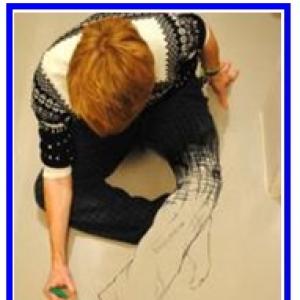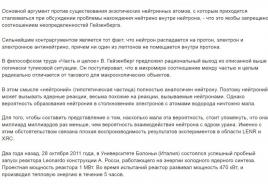17 primary points in physics. Unified State Exam
Assignment 23 EGE 2018 in the Russian language, theory and practice.
To complete task 23, you need to know the following definitions:
Direct / figurative meaning of the word (metaphor, metonymy, synecdoche)
Synonyms (contextual synonym)
Antonyms (contextual antonym)
Homonyms
Phraseologisms
Borrowed words
Passive vocabulary (historicisms, archaisms, neologisms)
Restricted vocabulary (professionalism, vernacular vocabulary, jargon, dialectism)
Stylistically neutral, bookish, colloquial vocabulary
Changes in the exam 2017-2018
This year it is necessary to find one of the words (terms) in a certain meaning. The changes adopted in 2017 remain in 2018.
This is how task 23 looks like demo version on the official website of FIPI:From sentences 33–44, write out a word with the meaning: "Imbued with elation, a passionate desire to give significance to something that has no significance."
If, for example, the task states:"From sentences 1-10, write out a phraseological unit with the meaning:" .... "- perhaps among these sentences there will be several phraseological units, among which you need to choose exactly the one whose meaning is indicated in the assignment.
Lexical meaning of the word
This is the historically fixed "content" of the word. Words can have:
Direct meaning - the original, original meaning of the word.
Figurative meaning - a secondary value arising from the first. (He hung the picture on the wall. The word “hung” has a direct meaning. - A lot of work was hung on him. “Hanged” is used in a figurative sense).
Transfer by any similarity (color, shape, function) is called metaphor. (The eyeball is similarity in shape; it failed the exam and now has a tail - similarity based on function.)
Transferring a name from one subject to another based on the contiguity of these subjects is called metonymy. (Gold on a finger, crystal on the shelves, Pushkin in a bag, ate a plate).
One of the varieties of metonymy is synecdoche. Sinekdokha - transfer of the name of the whole to its part or vice versa. (Hey hat, where are you going? Extra mouth in the family).
Synonyms
These are words that usually belong to the same part of speech, different in sound and spelling, but the same in meaning. (The path is the road, to think is to reflect)
Contextual synonyms - words that have a similar meaning only within the proposed text. Outside of context, such words are not synonymous. (Contextual synonyms of the verbspeak ... Marya Kirillovnapoured about loved ones, he was silent. Nobody believed grandfather. Even angry old womenshamkali that devils did not have beaks when they were born (Paust.))
Antonyms
These are the words usually belonging to the same part of speech, different in sound and spelling, but the same in meaning.
(White-black, talk-silent, good-evil)
Contextual antonyms - words that are in antonymic relations only in a certain context. They may have different grammatical forms and treat different parts speech. (I'm stupid and you're smartalive, and I'm dumbfounded (M. Tsvetaeva))
Homonyms
These are the words the same in sound and spelling, but different in meaning. Do not always belong to the same part of speech.
Homonyms are complete and partial.
Full homonyms are words of one part of speech in which all grammatical forms coincide. For example: a key (with which we open the door) and a key (water source).
Partial homonyms are words for which not all grammatical forms are the same.
Phraseologisms
These are stable, indivisible, non-free phrases that are stored in memory and are always used together in one definite meaning. As a rule, the meaning of phraseological units does not lie on the surface. Phraseologism is not the sum of the meanings of words, but one meaning for several words combined into a phrase.
Borrowed words
These are words that came to the Russian language from other languages. Not a single language, not counting the languages \u200b\u200bof isolated peoples that do not have contact with other peoples.
Examples: mathematics (from Greek), pearls (from turkic languages), herring (from Scandinavian languages), tie (from German), sailor (from Dutch), football (from English), broth (from French), sonata (from Italian), guitar (from Spanish), dumplings (from Finnish) , hamlet (from Hungarian).
Passive stock vocabulary
(outdated or not yet well known)
Histories - outdated words that have gone out of use due to the disappearance of the realities of reality, which they denoted. (Example: mayor, boyar, etc.)
Archaisms - obsolete words, replaced by modern synonyms. (Lanits - cheeks, hand-palm)
Neologisms - uhthen new words that have appeared recently in connection with the emergence of new realities. (At one time, these were words like Komsomol, pioneer.)
Restricted vocabulary
Dialectisms - uh these are words used only in certain territories.Examples: zhOna instead of wife, veksha - squirrel (northern dialect).
Professionalism - words used in oral speech in different professional environments.For example: a teapot - a programmer has a person who is poorly versed in computers, a beginner.
Slang vocabulary - words that I use in my speech by certain social strata of the population. Examples: mayhem (criminal argo) cool (youth)
Slang - is more often understood as "youth".
Argo - a dialect created by a group for the purpose of isolation (originally denoted a thieves' language)
Colloquial vocabulary - words with a stylistically lowered, rude, vulgar shade. These words include obscene words. For example, "whistle" - meaning "steal", "mug, muzzle" - meaning "face", etc.
Stylistically neutral, bookish, colloquial vocabulary
Neutral vocabulary - used in any situation (good, society, paint).
Book vocabulary - used primarily in writing (praiseworthy, association, painting).
Colloquial vocabulary - used in a casual conversation (coffin, spare wheel, hustler).
The minimum required points. Transfer of points into a five-point system.
Often parents and students ask the question: how many points in a subject must be scored for the subject to be considered passed? Here is a letter from Rosobrnadzor on the conditions for passing the OGE and transferring it to a five-point system. USE scores.
● Minimum points for subjects:
Letter of Rosobrnadzor No. 10220 dated 04/03/2018 on determining the minimum number of points for the main state exam and recommendations for transferring the amount of primary points for examination work of the OGE in a five-point grading system.
Recommendations for determining the minimum number of points for the main state exam (OGE), confirming the mastering of educational programs of basic general education by students in 2018.
Recommendations for transferring the amount of primary points for
examination papers of the main state examination (OGE) in a five-point assessment system
1. RUSSIAN LANGUAGE
The maximum number of points that an OGE participant can receive for completing the entire examination work, - 39 points.
2. MATH
The maximum number of points that an OGE participant can receive for completing the entire examination work is 32 points. Of these, for completing tasks in the "Algebra" module - 20 points, the "Geometry" module - 12 points.
The recommended minimum result of the examination work is 8 points, scored in total for completing the tasks of both modules, provided that at least 2 points of them were obtained in the module "Geometry".
* The results of the exam can be used when admitting students to specialized classes for training in educational programs middle general education.
Indicators, the lower boundaries of which correspond to the following primary scores, can serve as a guideline for selection to profile classes:
- for the natural science profile: 18 points, of which at least 6 in geometry;
- for an economic profile: 18 points, of which at least 5 in geometry;
- for the physical and mathematical profile: 19 points, of which at least 7 in geometry.
3. PHYSICS
The maximum number of points that an OGE participant can receive for completing the entire examination work is 40 points.
The scale for recalculating the total primary score for the performance of the examination work into a mark on a five-point scale:
* The results of the exam can be used when admitting students to specialized classes for training in educational programs of secondary general education. A guideline for selection to specialized classes can be an indicator, the lower limit of which corresponds to 30 points.
4. CHEMISTRY
The maximum number of points that a participant in the OGE in chemistry can receive for completing the entire examination work (without a real experiment) is -34 points.
The scale for recalculating the total primary score for the examination work to a mark on a five-point scale (work without a real experiment, demo version 1):
* The results of the exam can be used when admitting students to specialized classes for training in educational programs of secondary general education. A guideline for selection to specialized classes can be an indicator, the lower limit of which corresponds to 23 points.
The maximum number of points that a participant in the OGE in chemistry can receive for completing the entire examination work (with a real experiment) is 38 points.
The scale for recalculating the primary score for completing the examination work into a mark on a five-point scale (work with a real experiment, demo version 2):
* The results of the exam can be used when admitting students to specialized classes for training in educational programs of secondary general education. A guideline for selection to specialized classes can be an indicator, the lower limit of which corresponds to 25 points.
Continued on the second page.
| date | Unified State Exam |
|---|---|
| Early period | |
| March 20 (Fri) | geography, literature |
| March 23 (Mon) | russian language |
| March 27 (Fri) | mathematics B, P |
| March 30 (Wed) | foreign languages (excluding the section "Speaking"), biology, physics |
| April 1 (Wed) | |
| April 3 (Fri) | social studies, informatics and ICT |
| April 6 (Mon) | history, chemistry |
| April 8 (Wed) | reserve: geography, chemistry, informatics and ICT, foreign languages \u200b\u200b(section "Speaking"), history |
| April 10 (Fri) | reserve: foreign languages \u200b\u200b(except for the section "Speaking"), literature, physics, social studies, biology |
| April 13 (Mon) | reserve: Russian language, mathematics B, P |
| The main stage | |
| May 25 (Mon) | geography, literature, informatics and ICT |
| May 28 (Thu) | russian language |
| June 1 (Mon) | mathematics B, P |
| June 4 (Thu) | history, physics |
| June 8 (Mon) | social science, chemistry |
| June 11 (Thu) | foreign languages \u200b\u200b(except for the section "Speaking"), biology |
| June 15 (Mon) | foreign languages \u200b\u200b(section "Speaking") |
| June 16 (Tue) | foreign languages \u200b\u200b(section "Speaking") |
| June 18 (Tue) | reserve: history, physics |
| June 19 (Fri) | reserve: geography, literature, informatics and ICT, foreign languages \u200b\u200b(section "Speaking") |
| June 20 (Sat) | reserve: foreign language (except for the section "Speaking"), biology |
| June 22 (Mon) | reserve: Russian |
| June 23 (Tue) | reserve: social science, chemistry |
| June 24 (Wed) | reserve: history, physics |
| June 25 (Thu) | reserve: mathematics B, P |
| June 29 (Mon) | reserve: in all academic subjects |
The number of participants in the Unified State Exam in Physics in 2018 (main day) was 150,650 people, including 99.1% of this year's graduates. The number of exam participants is comparable to the previous year (155,281 people), but lower than the number in 2016 (167,472 people). In percentage terms, the number of participants in the Unified State Exam in Physics was 23% of the total number of graduates, which is slightly lower than last year. A slight decrease in the number of those taking the exam in physics may be due to an increase in universities accepting entrance test computer science.
The largest number of USE participants in physics is noted in Moscow (10,668), the Moscow region (6546), St. Petersburg (5652), the Republic of Bashkortostan (5271) and Krasnodar Territory (5060).
The average USE score in physics in 2018 was 53.22, which is comparable to last year's indicator (53.16 test points). The maximum test score was scored by 269 exam participants from 44 constituent entities of the Russian Federation; in the previous year, there were 278 people with 100 points. The minimum USE score in physics in 2018, as in 2017, was 36 tb., But in the primary points this was 11 points, compared with 9 primary points in the previous year. The share of exam participants who did not exceed the minimum score in 2018 was 5.9%, which is slightly higher than those who did not reach the minimum level in 2017 (3.79%).
In comparison with the two previous years, the share of poorly trained participants has slightly increased (21-40 tb.). The share of high-scorers (61-100 tb) increased, reaching the maximum values \u200b\u200bin three years. This allows us to speak of an increase in differentiation in the training of graduates and an increase in the quality of training of students studying a specialized course in physics.
In 2018, the share of exam participants who scored 81-100 points was 5.61%, which is higher than in 2017 (4.94%). For the exam in physics, the significant range is from 61 to 100 test points, which demonstrates the readiness of graduates to successfully continue their education in universities. This year this group of graduates has increased compared to the previous year and amounted to 24.22%.
More detailed analytical and methodological materials The Unified State Exam 2018 is available here.
Our website contains about 3000 tasks for preparing for the exam in physics in 2019. Overall plan the examination paper is presented below.
THE EXAMINATION PLAN OF THE USE IN PHYSICS 2019
Designation of the level of difficulty of the task: B - basic, P - increased, C - high.
Verifiable content items and activities |
Difficulty level of the task |
Maximum score for completing the task |
| Exercise 1. Uniform straight motion, uniformly accelerated rectilinear motion, circular motion | ||
| Task 2. Newton's laws, universal gravitation law, Hooke's law, friction force | ||
| Task 3. Law of conservation of momentum, kinetic and potential energies, work and power of force, law of conservation of mechanical energy | ||
| Task 4. Equilibrium condition solid, Pascal's law, Archimedes force, mathematical and spring pendulums, mechanical waves, sound | ||
| Task 5. Mechanics (explanation of phenomena; interpretation of the results of experiments presented in the form of tables or graphs) | ||
| Task 6. Mechanics (change in physical quantities in processes) | ||
| Task 7. Mechanics (establishing correspondence between graphs and physical quantities; between physical quantities and formulas) | ||
| Task 8. The relationship between pressure and mean kinetic energy, absolute temperature, relationship between temperature and average kinetic energy, Mendeleev - Clapeyron equation, isoprocesses | ||
| Task 9. Work in thermodynamics, the first law of thermodynamics, heat engine efficiency | ||
| Task 10. Relative air humidity, amount of heat | ||
| Task 11. MKT, thermodynamics (explanation of phenomena; interpretation of the results of experiments presented in the form of tables or graphs) | ||
| Task 12. MKT, thermodynamics (change in physical quantities in processes; establishing correspondence between graphs and physical quantities, between physical quantities and formulas) | ||
| Task 13. Principle of superposition of electric fields, magnetic field of a conductor with current, Ampere force, Lorentz force, Lenz rule (determination of direction) | ||
| Task 14. Electric charge conservation law, Coulomb's law, capacitor, current strength, Ohm's law for a section of a circuit, series and parallel connection of conductors, work and current power, Joule-Lenz law | ||
| Task 15. Flux of the vector of magnetic induction, Faraday's law of electromagnetic induction, inductance, energy of the magnetic field of a coil with a current, oscillatory circuit, laws of reflection and refraction of light, path of rays in a lens | ||
| Task 16. Electrodynamics (explanation of phenomena; interpretation of the results of experiments presented in the form of tables or graphs) | ||
| Task 17. Electrodynamics (change in physical quantities in processes) | ||
| Task 18. Electrodynamics and the basics of SRT (establishing correspondence between graphs and physical quantities, between physical quantities and formulas) | ||
| Task 19. Planetary model of the atom. Nucleon model of the nucleus. Nuclear reactions. | ||
| Task 20. Photons, line spectra, the law of radioactive decay | ||
| Task 21. Quantum physics (change in physical quantities in processes; establishing correspondence between graphs and physical quantities, between physical quantities and formulas) | ||
| Task 22. | ||
| Task 23. Mechanics - Quantum Physics (Methods of Scientific Cognition) | ||
| Task 24. Elements of astrophysics: solar system, stars, galaxies | ||
| Task 25. Mechanics, molecular physics (computational problem) | ||
| Task 26. Molecular physics, electrodynamics (design problem) | ||
| Task 27. | ||
| Task 28 (C1). Mechanics - quantum physics (qualitative problem) | ||
| Task 29 (C2). Mechanics (design problem) | ||
| Task 30 (C3). Molecular physics (computational problem) | ||
| Task 31 (C4). Electrodynamics (design problem) | ||
| Task 32 (C5). Electrodynamics, quantum physics (computational problem) |
The correspondence between the minimum primary scores and the minimum test scores of 2019. Order on amendments to Appendix No. 1 to the order of the Federal Service for Supervision in Education and Science.
THRESHOLD SCORE
The order of Rosobrnadzor established the minimum number of points, confirming the mastering by the participants of examinations of the basic general education programs of secondary (complete) general education in accordance with the requirements of the federal state educational standard secondary (complete) general education. PHYSICS THRESHOLD: 11 primary points (36 test points).
EXAMINATION FORM
You can download high quality forms by following the link.
WHAT YOU CAN TAKE WITH YOURSELF TO THE EXAM
The physics exam allows the use of a ruler for plotting graphs, optical and electrical circuits; non-programmable calculator that provides arithmetic calculations (addition, subtraction, multiplication, division, root extraction) and calculation trigonometric functions (sin, cos, tg, ctg, arcsin, arcos, arctg), and also does not function as a means of communication, database storage and does not have access to data transmission networks (including the Internet). ...







